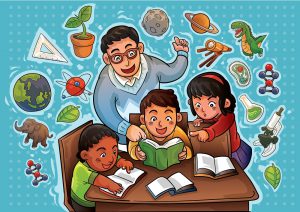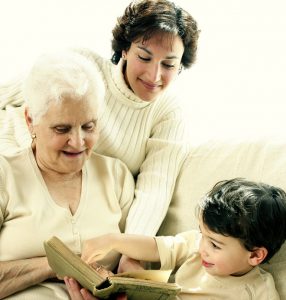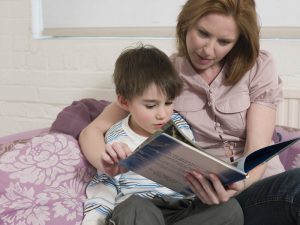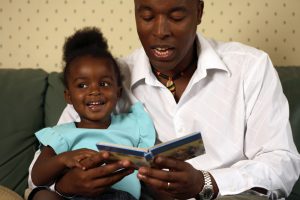In this post, we will discuss some methods and strategies using which you can effectively teach your kid to read at home and prepare the preschoolers to be ready for their future classroom curriculum.
A child’s brain at an early age is a lot different from a grown-up kid in various ways so you should use the right techniques to make them interested in what you are trying to teach them and use methods that make it easy for them to process the information.
At an early age when the brain is developing very fast, it is very wise to help your kid to learn skills like reading because it will not only be learned by them much quicker than a person with a developed brain but it also boosts up the process of their brain development.
When you spend the time with your kid to teach them the skills like reading it builds a strong connection between you and them which will help you to become the best teacher they could ever have in their whole lifetime.
Young kids are great learners and during their brain development phase, one should try to teach them the skills like reading because their brain is highly benefited by the effort they make to learn new skills. Children at an early age have a great potential to learn and they are highly curious about various things, so one should be ready to use the right methods to help them in doing this.
Although we are suggesting here to help your kid learn reading at an early age, this particular subject is highly debated by parents of different mentalities because many people believe that kids are not ready to learn such skills before they start to speak.
Surprisingly, a baby can start to learn reading from an age of three months and researches have proven that a toddler can learn both verbal and non-verbal language from the age of 3 months depending upon what their brain is absorbing from their surroundings.
Babies have a rapidly developing brain and according to the experts they are very efficient in learning new things before the age of five that’s why it is called the window of opportunity.
Three phases of teaching your kid about the language:-
Phase One
a) Reading to Your Kid Frequently
Storytelling is not only something you do to entertain your kids but it also helps them to know about the language usage. Reading to your kids frequently gives your child’s brain an exposure to the language which is very necessary for them to learn it as quickly as possible.
b) Generating Responses
It does not matter whether your child is able to speak or reply but you should focus on getting a response from your kid when you are communicating with them or telling them a story.
The best way to get a response is to ask open-ended questions, though it is obvious you will not get a verbal reply from a child before a certain age, your patience can do a great work in order to make them respond.
c) Introduce them to Books Early
Most people prefer to keep the books on the shelf when they have a kid in the house with the fear that the kid may tear the book or spoil it in some way but you should make some books accessible to the kids along with their toys at an early age.
When a kid sees a book as something to play with it becomes easy for you to make them interested in the utility of the written material.
The kid’s curiosity to know about the usage of a book gives you an excellent opportunity to start the basics lessons.
d) Word Sound Associations

The conventional way of teaching focuses on teaching kids the alphabets first before they learn how to make words but when you are dealing with a preschooler your approach should be different from that.
In order to make the word sound association, you should read to your kids by pointing to the words in the books that you are speaking over and over again until their brain starts to make connections between written symbols and the pronunciation.
Phase Two
a) Introduction to Alphabets
When you see that the kid has developed the word awareness it is the right time to teach them about the alphabets. The alphabet song is an effective method for teaching these basics to the kids but you should use your own creativity to help them understand the sound made by each of the alphabets in a word.
Lowercase alphabets are mostly used in the language so your priority should be to teach them the lower case alphabets before the uppercase alphabets.
Here’s a Youtube video on teaching three letter words to kids using vowel sounds:-
b) Phonemic Awareness
The most effective method in teaching kids how to read is to use the phonemic awareness which is a term used for indicating the sound associated with the letters. The 26 letters can produce about 44 different sounds and by knowing the details of phonemics you can help a child’s brain to comprehend the written material very efficiently.
One of the products that we recommend which have been quite popular for teaching kids how to learn reading named “Child Learning Reading Program” is based on phonics.
c) Teaching Rhymes
As we have discussed the phonemic awareness in the above paragraph, one very easy way to improve your kid’s phonemic awareness and letter recognition is to teach them rhymes.
Read rhymes to your kids as frequently as possible and find out what rhymes they find easy to understand and allow them to play with the words.
Phase Three

a) Introduction to the Stories
Once your child is prepared enough to read and comprehend stories you should focus on improving their vocabulary using their phonics awareness.
Make them read whole stories and ask them to explain what they have understood afterward so that they can work on their vocabulary. It is very much helpful for kids to look at images in order to make sense of the story they have been reading so you should allow them to use any of the aid that helps them to understand the written material.
b) Give them a Chance for Storytelling
First, it was you who used to tell stories but as your kid grows to understand the language better you should allow them to be the storyteller. Once they have finished reading a story you should let them explain the story as they have understood, using props like puppets can be greatly helpful in this process.
It is ok for you to correct the child once they have finished storytelling but it is more important to keep the process fun-filled.
You can also try some interesting games that help kids to learn reading. This is all you need to teach your kids about how to learn reading at home which will lay the necessary foundation for them, for in-depth strategies and expert methods we recommend you to use the product “child learning reading“.
Thank you so much for visiting our site, we hope you found this content useful. We would love to hear your views, suggestions, and opinions about this post, so kindly share your thoughts with us by commenting below.
For any queries, drop us a message using our contact page.


I totally agree with what you have said here and I know that it works because my son is proof of this. I started reading him stories when he was in my belly and I continued to read to him when he was born and every day after that. He is now 9 years old and even before he started school, he was a good reader and still today loves books and goes on to read every day! He is very fluent in reading and gets great marks at school and compared to his other friends, when I speak to their mum’s, they always complain that their kids don’t like to read or it’s a struggle to get them to read a book. I don’t have this problem because I made reading a fun thing and incorporated it into my child’s life from a very early stage which helped him to learn to speak better and read faster than most from his age group. I am now doing the same for my daughter and I hope that she too will follow in her bother’s foot steps. I also bought books with phonics and go to the library often to get different books from what we have at home but books in general are loved in my house hold and I believe it is very important to get this message across.
It is a great pleasure to hear from someone who has applied these strategies successfully in her life. We are really honoured to receive a comment from you because this is a real life example that proves that these techniques really works. We really appreciate the fact that you have gifted the skill of reading to your son at such an early stage and we wish you a great luck for doing the same in case of your daughter.
Helping your children read is such an important step, it helps them with their imagination and the earlier you start the more they will benefit.
I also found reading to my son very rewarding, especially when he corrects me if i miss a word.
Your tips are great for new parents, read to them and ask them questions about the story. They will start to follow the words and start associating the sounds with the different words. They will pick it quicker the more you do it.
We used to read to our son every night at bed time.
Great post
Thank you John for the comment.
We are happy to hear from someone who understands the importance of what we are trying to say here. Teaching your child to read is one of the most important skills you can gift them in their early childhood that will enhance their imagination and help with their brain development.